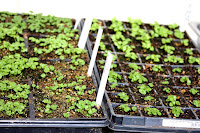Globe Basil is Ocimum basilicum
 |
| Globe Basil seedlings |
The small globe basil varieties are just as easy to grow, pack a wallop of flavor and require considerably less effort to clean for large scale processing such as pesto making and drying. Why? because the leaves and stems can all go into the dryer, oven and food processor.
The basils with woody stems require that each leaf be removed either before cleaning the entire stem or in a colander. With the little globe basil varieties, I cut off the top of the plant, rinse in the colander, dry it and use it.
 |
| globe basil seedlings |
Because of their size, they are wonderful container plants and as a mini-front-of-the-border hedge for a sunny spot.
Ramona Werst, author of the garden blog, "Ramona's Basil Garden" writes about all things basil. There are several basil varieties available for sale at her site.
 |
| Poppy Joe's globe basil |
Phagat's site points out that globe or small leafed basil has many names: Globe Greek, Spicy Globe, and Sweet Bush." This year I started seeds left over from last year and added one new variety.
Seed Savers points out that the plants grow 12-18 inches tall. Plant seeds 1/8th inch deep (press into soil or sprinkle with vermiculite). Germination can take up to a month and the seeds will just sit there if temperatures are below 65- degrees.
Thin the seedlings or transplant them 4 to 6 inches apart for a delicious, little hedge. More seed sources at this link.
Poppy Joe's is new to me this year. Joe matures at 12 to 14 inches, It's claim to fame is disease resistance so I did a little research and found that to be inaccurate. The University of MN conducted studies and found that even Poppy Joe is susceptible to downy mildew. BUT they added, "Varieties with no to low disease are not necessarily good substitutes for susceptible sweet basil varieties. They often have different leaf color and flavor, dramatically affecting the final product."
 Symptoms that tell you to apply fungicide, "Infected leaves first turn yellow in areas restricted by major
veins, with time the entire leaf turns yellow."
Symptoms that tell you to apply fungicide, "Infected leaves first turn yellow in areas restricted by major
veins, with time the entire leaf turns yellow."Prevention of mildew is the usual: "Increase row width and distance between plants to provide good air movement between plants to allow leaves to dry quickly after rain, dew or irrigation. Use drip irrigation if possible. If sprinkler irrigation is the only option, water deeply and infrequently early on a sunny day so leaves dry quickly in the sun. In greenhouse production, adjust ventilation to reduce humidity."
Some cooks complain that globe basil is not as smooth coming out of the food processor as Genovese. This Boston Globe link has a fascinating recipe for a pesto with globe basil, parsley, cilantro, and perilla, all of which we have in abundance in our garden this year.
The site Medicinal Herb Information says that it's also good for us: "Antispasmodic, antidepressant, antiseptic, stimulant, tonic, febrifuge, diaphoretic, nervine, antibacterial, expectorant, appetizer, carminative, galactagogue, stomachic". And, don't forget it is known for its ability to enhance romance.
How do you like to use your basil? Any recipes and ideas to share?


Comments